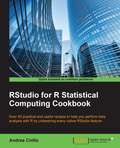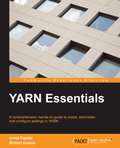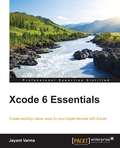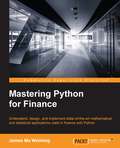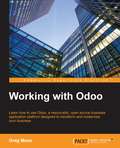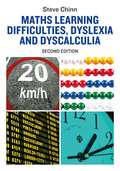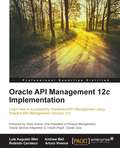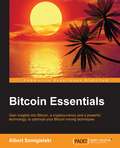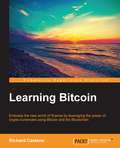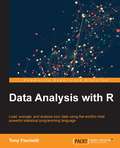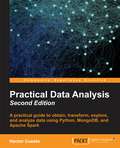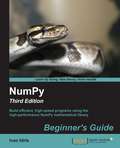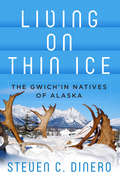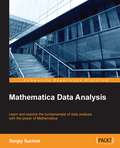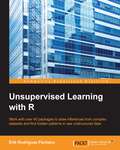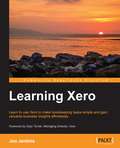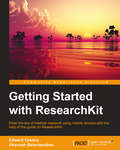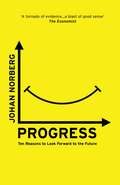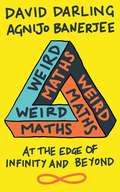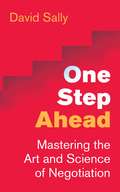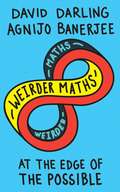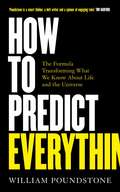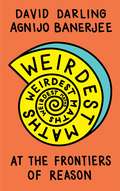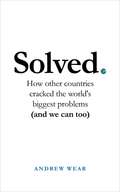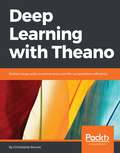- Table View
- List View
RStudio for R Statistical Computing Cookbook
by Andrea CirilloOver 50 practical and useful recipes to help you perform data analysis with R by unleashing every native RStudio feature About This Book * 54 useful and practical tasks to improve working systems * Includes optimizing performance and reliability or uptime, reporting, system management tools, interfacing to standard data ports, and so on * Offers 10-15 real-life, practical improvements for each user type Who This Book Is For This book is targeted at R statisticians, data scientists, and R programmers. Readers with R experience who are looking to take the plunge into statistical computing will find this Cookbook particularly indispensable. What You Will Learn * Familiarize yourself with the latest advanced R console features * Create advanced and interactive graphics * Manage your R project and project files effectively * Perform reproducible statistical analyses in your R projects * Use RStudio to design predictive models for a specific domain-based application * Use RStudio to effectively communicate your analyses results and even publish them to a blog * Put yourself on the frontiers of data science and data monetization in R with all the tools that are needed to effectively communicate your results and even transform your work into a data product In Detail The requirement of handling complex datasets, performing unprecedented statistical analysis, and providing real-time visualizations to businesses has concerned statisticians and analysts across the globe. RStudio is a useful and powerful tool for statistical analysis that harnesses the power of R for computational statistics, visualization, and data science, in an integrated development environment. This book is a collection of recipes that will help you learn and understand RStudio features so that you can effectively perform statistical analysis and reporting, code editing, and R development. The first few chapters will teach you how to set up your own data analysis project in RStudio, acquire data from different data sources, and manipulate and clean data for analysis and visualization purposes. You'll get hands-on with various data visualization methods using ggplot2, and you will create interactive and multidimensional visualizations with D3.js. Additional recipes will help you optimize your code; implement various statistical models to manage large datasets; perform text analysis and predictive analysis; and master time series analysis, machine learning, forecasting; and so on. In the final few chapters, you'll learn how to create reports from your analytical application with the full range of static and dynamic reporting tools that are available in RStudio so that you can effectively communicate results and even transform them into interactive web applications. Style and approach RStudio is an open source Integrated Development Environment (IDE) for the R platform. The R programming language is used for statistical computing and graphics, which RStudio facilitates and enhances through its integrated environment. This Cookbook will help you learn to write better R code using the advanced features of the R programming language using RStudio. Readers will learn advanced R techniques to compute the language and control object evaluation within R functions. Some of the contents are: * Accessing an API with R * Substituting missing values by interpolation * Performing data filtering activities * R Statistical implementation for Geospatial data * Developing shiny add-ins to expand RStudio functionalities * Using GitHub with RStudio * Modelling a recommendation engine with R * Using R Markdown for static and dynamic reporting * Curating a blog through RStudio * Advanced statistical modelling with R and RStudio
YARN Essentials
by Amol Fasale Nirmal KumarIf you have a working knowledge of Hadoop 1.x but want to start afresh with YARN, this book is ideal for you. You will be able to install and administer a YARN cluster and also discover the configuration settings to fine-tune your cluster both in terms of performance and scalability. This book will help you develop, deploy, and run multiple applications/frameworks on the same shared YARN cluster.
Xcode 6 Essentials
by Jayant VarmaThis book is aimed at developers who want to make applications for Apple devices with Xcode. iOS developers who have experience using other frameworks and languages can now migrate to Xcode and build creative, native apps.
Mastering Python for Finance
by James Ma WeimingIf you are an undergraduate or graduate student, a beginner to algorithmic development and research, or a software developer in the financial industry who is interested in using Python for quantitative methods in finance, this is the book for you. It would be helpful to have a bit of familiarity with basic Python usage, but no prior experience is required.
Working with Odoo
by Greg MossLearn how to use Odoo, a resourceful, open source business application platform designed to transform and modernize your business About This Book * Configure, manage, and customize Odoo to fit the needs of your business * Learn about the new Odoo 8 website builder and e-commerce features that are seamlessly integrated with Odoo's business applications * Perform step-by-step configurations of the most important Odoo applications using real-world examples Who This Book Is For This book is perfect for people who have never used Odoo and for those who would like to learn about more advanced features such as creating your own custom modules. In order to get the most out of this book, you should be comfortable with downloading and installing software and understand basic business concepts such as sales, purchasing, inventory management, and basic accounting. What You Will Learn * Configure a functioning customer relationship management system * Set up a purchasing and receiving system for your company that allows you to track inventory, costs, and profit * Implement manufacturing operations and processes using real-world examples that you can put to use in your own company * Discover the capabilities of Odoo's financial accounting and reporting features * Integrate powerful human resource applications that simplify the collection and management of employee information * Utilize Odoo's full featured project management application to organize tasks and track time and costs associated with billable projects * Customize Odoo without writing a line a code In Detail Odoo continues to gain momentum throughout the world in regards to providing the best platform for open source ERP installations. Now with Odoo 8, you have access to a powerful website builder, integrated e-commerce features, and a fast-growing community to help transform and modernize your business. With this practical guide, you will cover the essential modules to get Odoo up and running for your company. After installing Odoo, you will use its sales management application to enter quotes, create sales orders, and invoice customers. You will then learn how to integrate the CRM application to manage your leads and convert them into lucrative opportunities and sales. Next, you will set up your own purchase management system, assigning products to suppliers and tracking orders with the new warehouse management and routing system. Finally, you will learn how to use analytics to track project expenses and keep your accounts simple and easy to maintain and build an Odoo module to extend its functionality and make it work for you. Working with Odoo covers all the core installation and usage functionalities of this popular tool, helping you to fully implement a working ERP system through practical, advanced, real-world examples. Style and approach This book is a practical guide that uses real-world examples to teach you how to implement Odoo into your business.
Maths Learning Difficulties, Dyslexia and Dyscalculia: Second Edition (Dyslexia Essentials Ser.)
by Steve ChinnWritten by a world authority on maths difficulties in children, this accessible guide provides tried and tested visual strategies and tailored techniques to help teachers and parents support children with SpLDs who need help with maths.Drawing on the latest research, into areas such as cognition and meta-cognition, along with the authors' decades of teaching experience, the book offers insight into how maths learning difficulties, including dyslexia, dyscalculia and maths anxiety, make maths difficult. Each chapter looks at foundational areas of maths learning that children may struggle with, from early number experiences to basic addition and subtraction, times tables, measurement and more. Essential reading for any teacher, learning assistant or parent supporting children with maths.
Oracle API Management 12c Implementation
by Andrew Bell Luis Augusto WeirLearn how to successfully implement API management using Oracle's API Management Solution 12c About This Book * Explore the key concepts, goals, and objectives of API Management and learn how to implement it using the Oracle API Management Solution * Understand the concepts and objectives of the Application Service Governance (ASG), along with the governance framework that encompasses people, processes, and technology * Get to grips with API Management readiness assessments, gap analysis, digital reference architecture, and implementation roadmaps Who This Book Is For This book is for Enterprise Architects, Solution Architects, Technical Architects, and SOA and API consultants who want to successfully implement API Management using the Oracle API Management Solution products. What You Will Learn * Understand how to manage a set of APIs * Discover the differences and similarities between API Management and SOA Governance, and where and how these two disciplines converge into Application Services Governance (ASG) * Grasp information about ASG and how to define an ASG governance framework * Understand the challenges for organizations looking to expose APIs to the external world. Identify common scenarios and how to solve them * Define an Oracle API management deployment topology * Install and configure Oracle API Catalog (OAC), Oracle API Manager (OAPIM), and Oracle API Gateway (OAG) * Learn about API subscriptions and API community management with the OAPIM portal * Implement Oracle API Manager (OAPIM) including creation, publishing, management and deprecation of APIs In Detail Oracle SOA Governance is a comprehensive, service-orientated governance solution that is designed to make the transition to SOA easier. API management is the discipline that governs the software development lifecycle of APIs. It defines the tools and processes needed to build, publish and operate APIs including the management of the community of developers around it. This book illustrates how to successfully implement API Management in your organization. To achieve this, the importance of defining an API management strategy and implementation roadmap so that capabilities are implemented in the right order and timeframes is described. It starts by describing all of the fundamental concepts around API Management and related disciplines such as SOA Governance and DevOps in order to dispel the confusion surrounding these topics. The book then takes you on the journey of implementing API Management, using a realistic case study of an organization that needs an API Management solution. You will start by identifying the key business drivers to implement APIs and then create an API Management strategy and a roadmap to realize this strategy. You'll then go through a number of use cases, each focused on addressing specific business requirements. These will help you understand each of the Oracle API Management products, how they fit into an overall architecture, and how to implement them. The book concludes by providing some tips and guidelines around defining a deployment topology for the Oracle API Management products and the steps to install them. Style and approach This book is a comprehensive guide to successfully implementing a complete API Management solution from inception to implementation. The initial chapters introduce you to Oracle SOA Governance and API Management and from there, chapters are mainly hands-on and provide a full step-by-step walkthrough of how to implement the products of the Oracle API management solution to address realistic use cases.
Bitcoin Essentials
by Albert Szmigielski<p>Blockchain is being billed as the technology of the future. Bitcoin is the first application of that technology. Mining is what makes it all possible. Exploring mining from a practical perspective will help you make informed decisions about your mining setup. Understanding what the future may hold for blockchains, and therefore for mining, will help you position yourself to take advantage of the impending changes. <p>This practical guide starts with an introduction to Bitcoin wallets, as well as mining hardware and software. You will move on to learn about different mining techniques using the CPU, GPU, FPGA, and ultimately the ASIC as an example. After this, you will gain an insight into solo mining and pool mining, and see the differences between the two. The book will then walk you through large-scale mining and the challenges faced during such operations. Finally, you will take a look into the future to see a world where blockchain-based applications are commonplace and mining is ubiquitous.</p>
Learning Bitcoin
by Richard CaetanoEmbrace the new world of fiance by leveraging the power of crypto-currencies using Bitcoin and the BlockchainAbout This BookSet up your own wallet, buy and sell Bitcoin, and execute custom transactions on the BlockchainLeverage the power of Bitcoin to reduce transaction costs and eliminate fraudA practical step-by-step guide to break down the Bitcoin technology to ensure safe transactionsWho This Book Is ForIf you are familiar with online banking and want to expand your finances into a resilient and transparent currency, this book is ideal for you. A basic understanding of online wallets and financial systems will be highly beneficial to unravel the mysteries of Bitcoin.What You Will LearnSet up your wallet and buy a Bitcoin in a flash while understanding the basics of addresses and transactionsAcquire the knack of buying, selling, and trading Bitcoins with online marketplacesSecure and protect your Bitcoins from online theft using Brainwallets and cold storageUnderstand how Bitcoin's underlying technology, the Blockchain, works with simple illustrations and explanationsConfigure your own Bitcoin node and execute common operations on the networkDiscover various aspects of mining Bitcoin and how to set up your own mining rigDive deeper into Bitcoin and write scripts and multi-signature transactions on the networkExplore the various alt-coins and get to know how to compare them and their valueIn DetailThe financial crisis of 2008 raised attention to the need for transparency and accountability in the financial world. As banks and governments were scrambling to stay solvent while seeking a sustainable plan, a powerfully new and resilient technology emerged.Bitcoin, built on a fundamentally new technology called "The Blockchain," offered the promise of a new financial system where transactions are sent directly between two parties without the need for central control.Bitcoin exists as an open and transparent financial system without banks, governments, or corporate support. Simply put, Bitcoin is "programmable money" that has the potential to change the world on the same scale as the Internet itself.This book arms you with immense knowledge of Bitcoin and helps you implement the technology in your money matters, enabling secure transactions.We first walk through the fundamentals of Bitcoin, illustrate how the technology works, and exemplify how to interact with this powerful and new financial technology. You will learn how to set up your online Bitcoin wallet, indulge in buying and selling of bitcoins, and manage their storage. We then get to grips with the most powerful algorithm of all times: the Blockchain, and learn how crypto-currencies can reduce the risk of fraud for e-commerce merchants and consumers.With a solid base of Blockchain, you will write and execute your own custom transactions. Most importantly, you will be able to protect and secure your Bitcoin with the help of effective solutions provided in the book. Packed with plenty of screenshots, Learning Bitcoin is a simple and painless guide to working with Bitcoin.Style and approachThis is an easy-to-follow guide to working with Bitcoin and the Blockchain technology. This book is ideal for anyone who wants to learn the basics of Bitcoin and explore how to set up their own transactions.
Data Analysis with R
by Tony FischettiLoad, wrangle, and analyze your data using the world's most powerful statistical programming language About This Book * Load, manipulate and analyze data from different sources * Gain a deeper understanding of fundamentals of applied statistics * A practical guide to performing data analysis in practice Who This Book Is For Whether you are learning data analysis for the first time, or you want to deepen the understanding you already have, this book will prove to an invaluable resource. If you are looking for a book to bring you all the way through the fundamentals to the application of advanced and effective analytics methodologies, and have some prior programming experience and a mathematical background, then this is for you. What You Will Learn * Navigate the R environment * Describe and visualize the behavior of data and relationships between data * Gain a thorough understanding of statistical reasoning and sampling * Employ hypothesis tests to draw inferences from your data * Learn Bayesian methods for estimating parameters * Perform regression to predict continuous variables * Apply powerful classification methods to predict categorical data * Handle missing data gracefully using multiple imputation * Identify and manage problematic data points * Employ parallelization and Rcpp to scale your analyses to larger data * Put best practices into effect to make your job easier and facilitate reproducibility In Detail Frequently the tool of choice for academics, R has spread deep into the private sector and can be found in the production pipelines at some of the most advanced and successful enterprises. The power and domain-specificity of R allows the user to express complex analytics easily, quickly, and succinctly. With over 7,000 user contributed packages, it's easy to find support for the latest and greatest algorithms and techniques. Starting with the basics of R and statistical reasoning, Data Analysis with R dives into advanced predictive analytics, showing how to apply those techniques to real-world data though with real-world examples. Packed with engaging problems and exercises, this book begins with a review of R and its syntax. From there, get to grips with the fundamentals of applied statistics and build on this knowledge to perform sophisticated and powerful analytics. Solve the difficulties relating to performing data analysis in practice and find solutions to working with "messy data", large data, communicating results, and facilitating reproducibility. This book is engineered to be an invaluable resource through many stages of anyone's career as a data analyst. Style and approach Learn data analysis using engaging examples and fun exercises, and with a gentle and friendly but comprehensive "learn-by-doing" approach.
Practical Data Analysis - Second Edition
by Hector Cuesta Dr Sampath KumarA practical guide to obtaining, transforming, exploring, and analyzing data using Python, MongoDB, and Apache Spark About This Book * Learn to use various data analysis tools and algorithms to classify, cluster, visualize, simulate, and forecast your data * Apply Machine Learning algorithms to different kinds of data such as social networks, time series, and images * A hands-on guide to understanding the nature of data and how to turn it into insight Who This Book Is For This book is for developers who want to implement data analysis and data-driven algorithms in a practical way. It is also suitable for those without a background in data analysis or data processing. Basic knowledge of Python programming, statistics, and linear algebra is assumed. What You Will Learn * Acquire, format, and visualize your data * Build an image-similarity search engine * Generate meaningful visualizations anyone can understand * Get started with analyzing social network graphs * Find out how to implement sentiment text analysis * Install data analysis tools such as Pandas, MongoDB, and Apache Spark * Get to grips with Apache Spark * Implement machine learning algorithms such as classification or forecasting In Detail Beyond buzzwords like Big Data or Data Science, there are a great opportunities to innovate in many businesses using data analysis to get data-driven products. Data analysis involves asking many questions about data in order to discover insights and generate value for a product or a service. This book explains the basic data algorithms without the theoretical jargon, and you'll get hands-on turning data into insights using machine learning techniques. We will perform data-driven innovation processing for several types of data such as text, Images, social network graphs, documents, and time series, showing you how to implement large data processing with MongoDB and Apache Spark. Style and approach This is a hands-on guide to data analysis and data processing. The concrete examples are explained with simple code and accessible data.
NumPy: Beginner's Guide - Third Edition
by Ivan IdrisThis book is for the scientists, engineers, programmers, or analysts looking for a high-quality, open source mathematical library. Knowledge of Python is assumed. Also, some affinity, or at least interest, in mathematics and statistics is required. However, I have provided brief explanations and pointers to learning resources.
Living on Thin Ice: The Gwich'in Natives of Alaska
by Steven C. DineroThe Gwich'in Natives of Arctic Village, Alaska, have experienced intense social and economic changes for more than a century. In the late 20th century, new transportation and communication technologies introduced radically new value systems; while some of these changes may be seen as socially beneficial, others suggest a weakening of what was once a strong and vibrant Native community. Using quantitative and qualitative data gathered since the turn of the millennium, this volume offers an interdisciplinary evaluation of the developments that have occurred in the community over the past several decades.
Mathematica Data Analysis
by Sergiy SuchokLearn and explore the fundamentals of data analysis with power of Mathematica About This Book * Use the power of Mathematica to analyze data in your applications * Discover the capabilities of data classification and pattern recognition offered by Mathematica * Use hundreds of algorithms for time series analysis to predict the future Who This Book Is For The book is for those who want to learn to use the power of Mathematica to analyze and process data. Perhaps you are already familiar with data analysis but have never used Mathematica, or you know Mathematica but you are new to data analysis. With the help of this book, you will be able to quickly catch up on the key points for a successful start. What You Will Learn * Import data from different sources to Mathematica * Link external libraries with programs written in Mathematica * Classify data and partition them into clusters * Recognize faces, objects, text, and barcodes * Use Mathematica functions for time series analysis * Use algorithms for statistical data processing * Predict the result based on the observations In Detail There are many algorithms for data analysis and it's not always possible to quickly choose the best one for each case. Implementation of the algorithms takes a lot of time. With the help of Mathematica, you can quickly get a result from the use of a particular method, because this system contains almost all the known algorithms for data analysis. If you are not a programmer but you need to analyze data, this book will show you the capabilities of Mathematica when just few strings of intelligible code help to solve huge tasks from statistical issues to pattern recognition. If you're a programmer, with the help of this book, you will learn how to use the library of algorithms implemented in Mathematica in your programs, as well as how to write algorithm testing procedure. With each chapter, you'll be more immersed in the special world of Mathematica. Along with intuitive queries for data processing, we will highlight the nuances and features of this system, allowing you to build effective analysis systems. With the help of this book, you will learn how to optimize the computations by combining your libraries with the Mathematica kernel. Style and approach This book takes a step-by-step approach, accompanied by examples, so you get a better understanding of the logic of writing algorithms for data analysis in Mathematica. We provide a detailed explanation of all the nuances of the Mathematica language, no matter what your level of experience is.
Unsupervised Learning with R
by Erik Rodriguez PachecoWork with over 40 packages to draw inferences from complex datasets and find hidden patterns in raw unstructured data About This Book * Unlock and discover how to tackle clusters of raw data through practical examples in R * Explore your data and create your own models from scratch * Analyze the main aspects of unsupervised learning with this comprehensive, practical step-by-step guide Who This Book Is For This book is intended for professionals who are interested in data analysis using unsupervised learning techniques, as well as data analysts, statisticians, and data scientists seeking to learn to use R to apply data mining techniques. Knowledge of R, machine learning, and mathematics would help, but are not a strict requirement. What You Will Learn * Load, manipulate, and explore your data in R using techniques for exploratory data analysis such as summarization, manipulation, correlation, and data visualization * Transform your data by using approaches such as scaling, re-centering, scale [0-1], median/MAD, natural log, and imputation data * Build and interpret clustering models using K-Means algorithms in R * Build and interpret clustering models by Hierarchical Clustering Algorithm's in R * Understand and apply dimensionality reduction techniques * Create and use learning association rules models, such as recommendation algorithms * Use and learn about the techniques of feature selection * Install and use end-user tools as an alternative to programming directly in the R console In Detail The R Project for Statistical Computing provides an excellent platform to tackle data processing, data manipulation, modeling, and presentation. The capabilities of this language, its freedom of use, and a very active community of users makes R one of the best tools to learn and implement unsupervised learning. If you are new to R or want to learn about unsupervised learning, this book is for you. Packed with critical information, this book will guide you through a conceptual explanation and practical examples programmed directly into the R console. Starting from the beginning, this book introduces you to unsupervised learning and provides a high-level introduction to the topic. We quickly move on to discuss the application of key concepts and techniques for exploratory data analysis. The book then teaches you to identify groups with the help of clustering methods or building association rules. Finally, it provides alternatives for the treatment of high-dimensional datasets, as well as using dimensionality reduction techniques and feature selection techniques. By the end of this book, you will be able to implement unsupervised learning and various approaches associated with it in real-world projects. Style and approach This book takes a step-by-step approach to unsupervised learning concepts and tools, explained in a conversational and easy-to-follow style. Each topic is explained sequentially, explaining the theory and then putting it into practice by using specialized R packages for each topic.
Learning Xero
by Jon JenkinsLearn to use Xero to make bookkeeping tasks simple and gain valuable business insights effortlessly About This Book * Explore the process of setting up and using Xero * Concise step-by-step instructions to teach you best practice bookkeeping * Discover performance enhancing add-ons to reduce your daily work Who This Book Is For Intended for those who want to learn how to use Xero to get better insights from their business data and learn the best practices of bookkeeping using Xero. Perhaps you have never used Xero, or perhaps you want to migrate from an existing accounting application to Xero. In either case, this book will get you up and running quickly. It would be useful to have a bit of familiarity with basic bookkeeping concepts, but no prior experience of Xero is required. What You Will Learn * Configure Xero from scratch and fine-tune it ready for use * Set up bank feeds and automate the bank reconciliation process * Create workflows and segregation of duties for sales and purchases * Run payrolls, giving employees the ability to request time off and generate their own payslips * Produce reports to gain a better understanding of your business data and make better quality decisions * Import and export data ready for analysis * Use the power of a mobile device to run your business from the palm of your hand * Manage your inventory with fully automated transaction processing In Detail The book begins by tackling the initial set up of Xero to ensure optimum configuration for success. From there, the next logical step is to set up the automated bank feeds, which is the best innovation in bookkeeping in years. Now that your bank data is ready for importing, we will tackle the most common transactional items, being sales invoices and purchase bills. Despite these being largely transactional, we will work through ways to automate the process where possible, save time, and avoid potential human errors along the way. Then we will start checking reports and analyze what is working or not and make changes to workflows and setups. The end result is that you will have a fully configured system ready to use and years of experience offering best practice solutions to what have been, for years, unnecessary roadblocks in your business. Style and approach This book contains easy-to-follow, step-by-step examples, explaining from start to finish how to set up and use Xero while implementing best practices of bookkeeping.
Getting Started with ResearchKit
by Edward Cessna Dhanush BalachandranEnter the era of medical research using mobile devices with the help of this guide on ResearchKit! About This Book * Create a simple clinical research app using most aspects of ResearchKit * Build a simple survey with various data types with the results printed on the screen. * A step-by-step guide introducing Apple's ResearchKit and techniques to incorporate it into various apps. Who This Book Is For This book is aimed at medical researchers with basic iOS coding knowledge and iOS developers looking to create clinical research apps. What You Will Learn * Learn to create customized consent form * Get introduced to two backend services: a simple backend server using Sinatra and Sage Bridge * Build a custom task (a conditional survey example) and a navigable task * Get an Overview of ResearchKit's open source repository and App Core * Interaction with the hardware of the device including the gyro and the motion sensors * Learn the basics of this revolutionary technology * Get introduced to the barebones app and learn to write your first code In Detail ResearchKit is an open source software development framework from Apple that lets you easily create mobile applications for clinical research studies. ResearchKit provides you the ability to orchestrate the administration of tasks and recording of the results. ResearchKit provides tasks in order to perform informed consent, active tasks, and surveys. Starting with the basics of the ResearchKit framework, this books walks you through the steps of creating iOS applications that could serve as the basis of a clinical research mobile app. This book will introduce readers to ResearchKit and how to turn your iPhone into into a clinical research tool. The book will start off by installing and building the research framework in line with the researcher's needs; during this, the reader will learn to embed ResearchKit in the application and create a small task. After this, the book will go a little deeper into creating modules for surveys, consents, and so on. The book will also cover the various aspects of privacy and security with regard to participant data, and how to build dashboards for visualizing medical data and results in line with the researcher's requirements: data backends, JSON serialization and deserialization, and so on. Readers will be able to fully utilize ResearchKit for medical research, will be able to get more and more patients to participate in their surveys, and will gain insights from the surveys using the dashboards created. Style and approach A hands-on guide with ample screenshots for you to follow and learn about ResearchKit. Each topic is explained sequentially and placed in context so that you can get a better understanding of every step in the process of creating clinical research apps.
Progress: Ten Reasons to Look Forward to the Future
by Johan NorbergA Book of the Year for The Economist and the Observer Our world seems to be collapsing. The daily news cycle reports the deterioration: divisive politics across the Western world, racism, poverty, war, inequality, hunger. While politicians, journalists and activists from all sides talk about the damage done, Johan Norberg offers an illuminating and heartening analysis of just how far we have come in tackling the greatest problems facing humanity. In the face of fear-mongering, darkness and division, the facts are unequivocal: the golden age is now.
Weird Maths: At the Edge of Infinity and Beyond
by David Darling Agnijo BanerjeeIs anything truly random? Does infinity actually exist? Could we ever see into other dimensions? In this delightful journey of discovery, David Darling and extraordinary child prodigy Agnijo Banerjee draw connections between the cutting edge of modern maths and life as we understand it, delving into the strange – would we like alien music? – and venturing out on quests to consider the existence of free will and the fantastical future of quantum computers. Packed with puzzles and paradoxes, mind-bending concepts and surprising solutions, this is for anyone who wants life&’s questions answered – even those you never thought to ask.
One Step Ahead: Mastering the Art and Science of Negotiation
by David SallyThe world's best negotiators have moved beyond the conventional wisdom by utilising cutting-edge studies and real-world results. It's time you did too. For over twenty years, David Sally has been teaching the art of negotiation at leading business schools and to executives at top companies. Now, using insights from social psychology and game theory, he delivers the proven, clear, actionable advice you need to stay one step ahead. By studying great examples, from Machiavelli to Wall Street, Xi Jinping and Barack Obama, he explores how the game&’s masters navigate the field strategically, craftily, even emotionally. The best know every negotiation is different and that your tactics are, in part, determined by your opponent. One Step Ahead will make sure that you have what it takes to come out on top, no matter who you are facing across the table.
Weirder Maths: At the Edge of the Possible
by David Darling Agnijo BanerjeeEven the most enthusiastic of maths students probably at one time wondered when exactly it would all prove useful in &‘real life&’. Well, maths reaches so far and wide through our world that, love it or hate it, we&’re all doing maths almost every minute of every day. David Darling and Agnijo Banerjee go in search of the perfect labyrinth, journey back to the second century in pursuit of &‘bubble maths&’, reveal the weirdest mathematicians in history and transform the bewildering into the beautiful, delighting us once again.
How to Predict Everything: The Formula Transforming What We Know About Life and the Universe
by William PoundstoneHow do you predict something that has never happened before? There&’s a useful calculation being employed by Wall Street, Silicon Valley and maths professors all over the world, and it predicts that the human species will become extinct in 760 years. Unfortunately, there is disagreement over how to apply the formula, and some argue that we might only have twenty years left. Originally devised by British clergyman Thomas Bayes, the theorem languished in obscurity for two hundred years before being resurrected as the lynchpin of the digital economy. With brief detours into archaeology, philology, and overdue library books, William Poundstone explains how we can use it to predict pretty much anything. What is the chance that there are multiple universes? How long will Hamilton run? Will the US stock market continue to perform as well this century as it has for the last hundred years? And are we really all doomed?
Weirdest Maths: At the Frontiers of Reason
by David Darling Agnijo BanerjeeMaths is everywhere, in everything. It&’s in the finest margins of modern sport. It&’s in the electrical pulses of our hearts and the flight of every bird. It is our key to secret messages, lost languages and perhaps even the shape of the universe of itself. David Darling and Agnijo Banerjee reveal the mathematics at the farthest reaches of our world – from its role in the plots of novels to how animals employ numerical skills to survive. Along the way they explore what makes a genius, why a seemingly simple problem can confound the best and brightest for decades, and what might be the great discovery of the twenty-first century. As Bertrand Russell once said, &‘mathematics, rightly viewed, possesses not only truth, but supreme beauty&’. Banerjee and Darling make sure we see it right again.
Solved: How other countries cracked the world's biggest problems (and we can too)
by Andrew WearDenmark is set to achieve 100 per cent renewable energy by 2030. Iceland has topped the gender equality rankings for a decade and counting. South Korea&’s average life expectancy will soon reach ninety. How have these places achieved such remarkable outcomes? And how can we apply those lessons to our own communities? The future we want is already here - it's just not evenly distributed. By bringing together for the first time tried and tested solutions to society's most pressing problems, from violence to inequality, Andrew Wear shows that the world we want to live in is already within reach. Solved is a much-needed dose of optimism in an atmosphere of doom and gloom. Informative, accessible and revelatory, it is a celebration of the power of human ingenuity to make the future brighter for everyone.
Deep Learning with Theano
by Christopher BourezDevelop deep neural networks in Theano with practical code examples for image classification, machine translation, reinforcement agents, or generative models. About This Book • Learn Theano basics and evaluate your mathematical expressions faster and in an efficient manner • Learn the design patterns of deep neural architectures to build efficient and powerful networks on your datasets • Apply your knowledge to concrete fields such as image classification, object detection, chatbots, machine translation, reinforcement agents, or generative models. Who This Book Is For This book is indented to provide a full overview of deep learning. From the beginner in deep learning and artificial intelligence, to the data scientist who wants to become familiar with Theano and its supporting libraries, or have an extended understanding of deep neural nets. Some basic skills in Python programming and computer science will help, as well as skills in elementary algebra and calculus. What You Will Learn • Get familiar with Theano and deep learning • Provide examples in supervised, unsupervised, generative, or reinforcement learning. • Discover the main principles for designing efficient deep learning nets: convolutions, residual connections, and recurrent connections. • Use Theano on real-world computer vision datasets, such as for digit classification and image classification. • Extend the use of Theano to natural language processing tasks, for chatbots or machine translation • Cover artificial intelligence-driven strategies to enable a robot to solve games or learn from an environment • Generate synthetic data that looks real with generative modeling • Become familiar with Lasagne and Keras, two frameworks built on top of Theano In Detail This book offers a complete overview of Deep Learning with Theano, a Python-based library that makes optimizing numerical expressions and deep learning models easy on CPU or GPU. The book provides some practical code examples that help the beginner understand how easy it is to build complex neural networks, while more experimented data scientists will appreciate the reach of the book, addressing supervised and unsupervised learning, generative models, reinforcement learning in the fields of image recognition, natural language processing, or game strategy. The book also discusses image recognition tasks that range from simple digit recognition, image classification, object localization, image segmentation, to image captioning. Natural language processing examples include text generation, chatbots, machine translation, and question answering. The last example deals with generating random data that looks real and solving games such as in the Open-AI gym. At the end, this book sums up the best -performing nets for each task. While early research results were based on deep stacks of neural layers, in particular, convolutional layers, the book presents the principles that improved the efficiency of these architectures, in order to help the reader build new custom nets. Style and approach It is an easy-to-follow example book that teaches you how to perform fast, efficient computations in Python. Starting with the very basics-NumPy, installing Theano, this book will take you to the smooth journey of implementing Theano for advanced computations for machine learning and deep learning.
